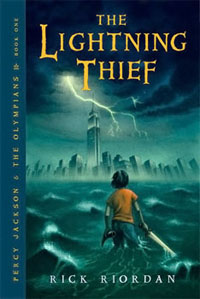 Reading Percy Jackson and the Lightning Thief was a fairly fascinating experience. Taken on its own merits, the novel is a perfectly acceptable piece of light fluffery. On the other hand, the Percy Jackson series is clearly a calculated effort to cash-in on the success of Harry Potter, and reading the novel from that point of view gives a great deal of insight into not only Riordan’s creative process, but also the elements that made Rowling’s work so successful.
Reading Percy Jackson and the Lightning Thief was a fairly fascinating experience. Taken on its own merits, the novel is a perfectly acceptable piece of light fluffery. On the other hand, the Percy Jackson series is clearly a calculated effort to cash-in on the success of Harry Potter, and reading the novel from that point of view gives a great deal of insight into not only Riordan’s creative process, but also the elements that made Rowling’s work so successful.
Basically, Riordan seeks to invert the structure of Harry Potter in every part. Thus, Potter’s magical school becomes Jackson’s magical summer camp. Potter hates his mundane home life, so Jackson loves his. The friendly headmaster Dumbledore becomes the hostile camp master Dionysus. And so forth.
You can also see this inversion being carried out on the larger structural level of the plot: Potter generally stays at his school and adventure must seek him out. Jackson, on the other hand, must venture forth on grand quests.
In general, this model of wholesale inversion is probably more effective at keeping the series fresh than if Riordan had decided to simply ape Rowling. But once you’ve spotted the trick, it becomes depressingly predictable. It also creates deeper problems for Riordan.
For example, one of the really beautiful things about Hogwarts was the irony of a kid who wanted to go to school. It’s an inversion of the natural order, and thus – on a subtle yet fundamental level – reinforces the otherworldliness of Rowling’s milieu. But a kid who hates school and wants to go to a summer camp? It’s bland vanilla even before you get to the random grab-bag of camp activities that make Quidditch look like a reasonable sporting event. (Riordan tends to tell rather than show. He wants the summer camp to be really cool, but he never spends the narrative time there necessary to invest the reader as deeply as Percy himself is apparently vested.)
The Lightning Thief also calls attention to another aspect of Harry Potter that sets it apart from the great bulk of fantasy fiction: Harry Potter is utterly humble in his origins. He is not born with any special powers. The only prophecy which applies to him is essentially exhausted before he hits his first birthday. Everything we see him accomplish, he accomplishes through hard work, determination, study, and the assistance of friends well-earned. (In this he shares much in common with Bilbo and Frodo.)
Percy Jackson, on the other hand, is Born Awesome. He’s the son of one of the most powerful gods, and so he’s inherently more powerful than everyone else around him. Ta da! And whereas Potter has his one small advantage stripped from him midway through the series, Jackson simply continues to accumulate power through divine fiat. We never see him work for anything. Or earn anything. At most he occasionally digs deep to find his hero genes and then unleashes the raw potential of his authorially-granted I’m So Special status.
Ultimately, the Percy Jackson series is to Harry Potter what The Sword of Shannara is to The Lord of the Rings: Riordan mugged Rowling in a dark alley, rifled her pockets, and shuffled the stuff he found into a slightly different order while scraping off the serial numbers. In the process quite a bit of the original’s charm and depth has been lost, which is perhaps only to be expected when you’re dealing with a knock-off.
On the other hand, Riordan’s writing, despite its shortcomings, is better than early Terry Brooks. And he also finds his own unique sense of grandeur and mystery (whereas Brooks only managed to turn everything he touched to mediocrity in The Sword of Shannara). So while the comparison may be apt, it is not entirely fair.
So while I can’t strongly recommend The Lightning Thief, I also wouldn’t dissuade you from it. It’s a bit of light fun, and the series as a whole tends to improve as it runs its course.
GRADE: C
Rick Riordan
Published: 2005
Publisher: Hyperion
Cover Price: $7.99
ISBN: 1423139494X
Buy Now!











